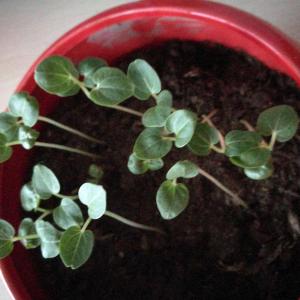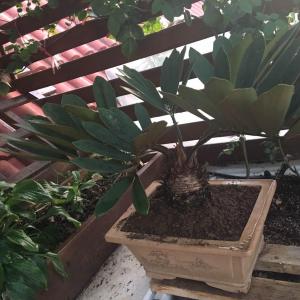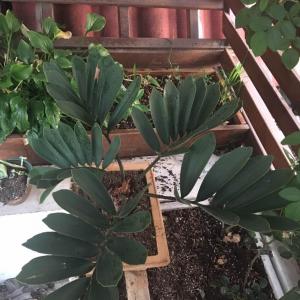成长记
Deanna Dubbs
2017年09月27日

This is a photo from 9-13-17. The day I bought my first 8 Succs. I didn’t think that this one had grown any, but now that I look at this photo it has indeed gotten taller!
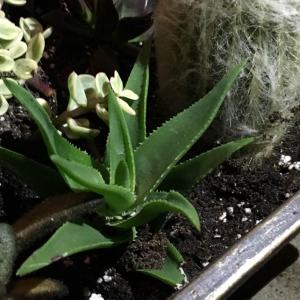

0
0
文章
Dummer. ゛☀
2017年09月27日

Grammatophyllum is a genus of 13 currently known orchid species. The name is derived from the Greek words “gramma” (a line or streak or mark) and “phyllon” (leaf), referring to the parallel leaf veins or the markings of the perianth. This epiphytic genus occurs in dense rainforest from Indo-China, to Indonesia, the Philippines, New Guinea, and the Southwest Pacific islands.
There are two distinct growth forms in this genus. The first has very long pseudobulbs, resembling sugar cane, bearing many leaves, arranged distichous (alternating in two opposite ranks). The second has rather short thick psuedobulbs which are not covered leaf bases and bear a few leaves around the top of the psuedobulbs. The psuedobulbs are sympodial in growth, with each new growth arising from the previous growth. The flowers of most Grammatophyllum species, are generally yellow and brown.
Light
Grammatophyllums grow well in moderate light intensity. Morning sun is best, until about noon. Observation of the leaf structure can be your best guide to the correct light conditions for which a type is particularly suited. Lime green colored foliage is an indication of proper light. Dark green foliage, while very attractive, is not conducive to the plant reaching it’s full blooming potential. Yellow colored foliage indicates too much light. In very mild climates, most members of this can be grown out of doors, with protection from the hot summer sun, and the colder nights of winter.
Temperature
The ideal annual temperature range for most members of the genus Grammatophyllum are 75 to 85 °F (24 to 30 °C) during the day and 55 to 60 °F (13 to 16 °C) at night. Plants will tolerate temperatures to 45 °F (10 °C) and up to 100 °F (38 °C) for short periods. At higher temperatures, air circulation and humidity must be increased or damage can occur.
Water
Grammatophyllums enjoy frequent watering, during their growing period, but will not tolerate wet feet for extended periods. However, when growth is completed, a 2 or 3 week rest period should follow to allow the growths to mature. Generally speaking, the growing season extends from March to October. The frequency of watering is relative to the container, the temperature, air circulation, and the amount of water retained in medium in the container. Watering should be done, so the roots are approaching dryness, before rewatering. In the warmer periods, several waterings a week can be done, without worry, if the roots can dry quickly. The roots are sensitive to fertilizer salt build up, so clear water flushes are necessary for good growth.
Fertilizer
Grammatophyllum plants should be fed consistently, when in full growth. During the spring through early fall, fertilizing every 7 days, with several clear waterings in between, will make your Grammatophyllum plants happy. In the late fall through winter, a light feeding once a month will suffice.
The fertilizer formula should match the potting medium. Use 20-10-20 with tree fern, charcoal, or various inorganic aggregates, but use 30-10-10 with fir bark. We recommend non-urea based fertilizers at half strength. Non urea fertilizers provide 100% immediately available nitrogen, which urea based fertilizers do not.
Whichever formula is selected, we recommend half strength at each application. As with most Orchids, Grammatophyllum roots are sensitive to fertilizer salt build up. Grammatophyllums are particularly fond of organic fertilizers, such as fish emulsion and manure teas. The organic fertilizers eliminate concern of salt build up in the medium.
Potting
Grammatophyllum do not resent being disturbed, so repotting should be undertaken whenever necessary. The best time is after all flowering has ceased and new growth is just beginning. To minimize root damage, a warm water soak for 10 minutes, will make most roots very pliable and easier to remove from the container.
While most Grammatophyllums will do well in clay or plastic pots. Some large-growing types such as Grammatophyllum speciosum are best grown in a wire or wooden basket. The strong rapid growing root system often breaks ordinary pots. The baskets allow free air flow over the roots, and eliminate over watering problems.
The potting medium must be well-drained, i.e. coarse fir bark, lava rock, pieces of broken pottery, chunks of tree fern, hardwood charcoal, etc. so that the roots can be wet, but then dry quickly.
When dividing Grammatophyllum plants, always divide into parts with at least four psuedobulbs. Remove any dead roots from the divisions, then lay the divisions aside until new root growth begins. At that time, usually a week or so, repot the divisions in their new pots. Now the plants can be watered and fertilized as usual, without worrying about rotting them, because they retained no roots in the division. Newly repotted plants should be placed in slightly lower light for several weeks.

There are two distinct growth forms in this genus. The first has very long pseudobulbs, resembling sugar cane, bearing many leaves, arranged distichous (alternating in two opposite ranks). The second has rather short thick psuedobulbs which are not covered leaf bases and bear a few leaves around the top of the psuedobulbs. The psuedobulbs are sympodial in growth, with each new growth arising from the previous growth. The flowers of most Grammatophyllum species, are generally yellow and brown.

Light
Grammatophyllums grow well in moderate light intensity. Morning sun is best, until about noon. Observation of the leaf structure can be your best guide to the correct light conditions for which a type is particularly suited. Lime green colored foliage is an indication of proper light. Dark green foliage, while very attractive, is not conducive to the plant reaching it’s full blooming potential. Yellow colored foliage indicates too much light. In very mild climates, most members of this can be grown out of doors, with protection from the hot summer sun, and the colder nights of winter.
Temperature
The ideal annual temperature range for most members of the genus Grammatophyllum are 75 to 85 °F (24 to 30 °C) during the day and 55 to 60 °F (13 to 16 °C) at night. Plants will tolerate temperatures to 45 °F (10 °C) and up to 100 °F (38 °C) for short periods. At higher temperatures, air circulation and humidity must be increased or damage can occur.

Water
Grammatophyllums enjoy frequent watering, during their growing period, but will not tolerate wet feet for extended periods. However, when growth is completed, a 2 or 3 week rest period should follow to allow the growths to mature. Generally speaking, the growing season extends from March to October. The frequency of watering is relative to the container, the temperature, air circulation, and the amount of water retained in medium in the container. Watering should be done, so the roots are approaching dryness, before rewatering. In the warmer periods, several waterings a week can be done, without worry, if the roots can dry quickly. The roots are sensitive to fertilizer salt build up, so clear water flushes are necessary for good growth.

Fertilizer
Grammatophyllum plants should be fed consistently, when in full growth. During the spring through early fall, fertilizing every 7 days, with several clear waterings in between, will make your Grammatophyllum plants happy. In the late fall through winter, a light feeding once a month will suffice.
The fertilizer formula should match the potting medium. Use 20-10-20 with tree fern, charcoal, or various inorganic aggregates, but use 30-10-10 with fir bark. We recommend non-urea based fertilizers at half strength. Non urea fertilizers provide 100% immediately available nitrogen, which urea based fertilizers do not.
Whichever formula is selected, we recommend half strength at each application. As with most Orchids, Grammatophyllum roots are sensitive to fertilizer salt build up. Grammatophyllums are particularly fond of organic fertilizers, such as fish emulsion and manure teas. The organic fertilizers eliminate concern of salt build up in the medium.

Potting
Grammatophyllum do not resent being disturbed, so repotting should be undertaken whenever necessary. The best time is after all flowering has ceased and new growth is just beginning. To minimize root damage, a warm water soak for 10 minutes, will make most roots very pliable and easier to remove from the container.
While most Grammatophyllums will do well in clay or plastic pots. Some large-growing types such as Grammatophyllum speciosum are best grown in a wire or wooden basket. The strong rapid growing root system often breaks ordinary pots. The baskets allow free air flow over the roots, and eliminate over watering problems.

The potting medium must be well-drained, i.e. coarse fir bark, lava rock, pieces of broken pottery, chunks of tree fern, hardwood charcoal, etc. so that the roots can be wet, but then dry quickly.
When dividing Grammatophyllum plants, always divide into parts with at least four psuedobulbs. Remove any dead roots from the divisions, then lay the divisions aside until new root growth begins. At that time, usually a week or so, repot the divisions in their new pots. Now the plants can be watered and fertilized as usual, without worrying about rotting them, because they retained no roots in the division. Newly repotted plants should be placed in slightly lower light for several weeks.
0
0
文章
Dummer. ゛☀
2017年09月23日

Cicada bugs emerge every 13 or 17 years to terrorize trees and the people who care for them. Are your trees at risk? Learn to minimize cicada damage to trees in this article. 
Do Cicadas Damage Trees?
Cicadas can damage trees, but not in the ways you might think. The adults might feed on leaves, but not enough to cause any serious or lasting damage. The larvae drop to the ground and dig down to the roots where they feed until it’s time to pupate. While root feeding robs the tree of nutrients that would otherwise help it grow, arborists have never documented any damage to the tree from this type of feeding.
Tree damage from cicada insects occurs during the egg laying process. The female lays her eggs under the bark of a twig or branch. The twig splits and dies, and the leaves on the twig turn brown. This condition is called “flagging.” You can spot flagging twigs and branches at a glance because of the contrast of brown leaves against the healthy green leaves on other branches.
Female cicadas are particular about the size of the branch or twig where they lay their eggs, preferring those that are about the diameter of a pencil. This means that older trees won’t sustain serious damage because their primary branches are much larger. Young trees, on the other hand, may be so severely damaged that they die from their injuries.
Minimizing Cicada Damage to Trees
Most people don’t want to wage chemical warfare in their own backyard to prevent tree damage from cicada insects, so here’s a list of prevention measures that don’t involve the use of insecticides:
Don’t plant new trees within four years of the cicadas emerging. Young trees are at high risk, so it’s best to wait until the danger has passed. Your Cooperative Extension agent can tell you when to expect the cicadas. Prevent cicada bugs in small trees by covering them with netting.
The netting should have a mesh size no longer than one quarter inch. Fasten the netting around the trunk of the tree just below the canopy to prevent emerging cicadas from climbing up the trunk. Clip off and destroy flagging damage. This reduces the population of the next generation by eliminating the eggs.

Do Cicadas Damage Trees?
Cicadas can damage trees, but not in the ways you might think. The adults might feed on leaves, but not enough to cause any serious or lasting damage. The larvae drop to the ground and dig down to the roots where they feed until it’s time to pupate. While root feeding robs the tree of nutrients that would otherwise help it grow, arborists have never documented any damage to the tree from this type of feeding.

Tree damage from cicada insects occurs during the egg laying process. The female lays her eggs under the bark of a twig or branch. The twig splits and dies, and the leaves on the twig turn brown. This condition is called “flagging.” You can spot flagging twigs and branches at a glance because of the contrast of brown leaves against the healthy green leaves on other branches.

Female cicadas are particular about the size of the branch or twig where they lay their eggs, preferring those that are about the diameter of a pencil. This means that older trees won’t sustain serious damage because their primary branches are much larger. Young trees, on the other hand, may be so severely damaged that they die from their injuries.

Minimizing Cicada Damage to Trees
Most people don’t want to wage chemical warfare in their own backyard to prevent tree damage from cicada insects, so here’s a list of prevention measures that don’t involve the use of insecticides:
Don’t plant new trees within four years of the cicadas emerging. Young trees are at high risk, so it’s best to wait until the danger has passed. Your Cooperative Extension agent can tell you when to expect the cicadas. Prevent cicada bugs in small trees by covering them with netting.

The netting should have a mesh size no longer than one quarter inch. Fasten the netting around the trunk of the tree just below the canopy to prevent emerging cicadas from climbing up the trunk. Clip off and destroy flagging damage. This reduces the population of the next generation by eliminating the eggs.
0
0
文章
Dummer. ゛☀
2017年09月22日

Disocactus flagelliformis commonly known as Rat Tail Cactus, is a cactus with a thick hanging stems, each with 8 – 13 ribs, up to 3.3 feet (1 m) long and up to 0.75 inches (1.9 cm) in diameter. The needle groups are tiny, almost fuzzy-looking and have 15 – 20 fine reddish-yellow spines each. Flowers are a beautiful magenta color, curved, up to 3 inches (7.5 cm) long and up to 1.5 inches (3.8 cm) in diameter.
Disocactus flagelliformis is epiphytic in the wild (it grows in trees). It is perfectly adapted to hanging baskets. It is the most cultivated species in the genus. Due to its ease of cultivation and attractive floral displays, Disocactus flagelliformis is often grown as an ornamental pot plant.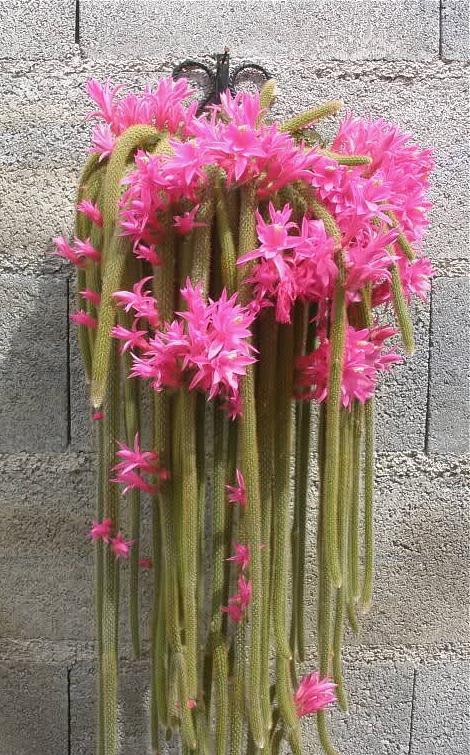
Growing Conditions
Light: Disocactus flagelliformis requires full sunlight. Hang the pot or basket in the sunniest window available. If possible, hang the plant outdoors in summer to give it fresh air and extra light.
Soil: A good draining soil mix that is gritty is advisable to use, which is sold and used for cacti and succulents.
Temperature: During the active growth period normal room temperatures are suitable. In winter these plants should be rested at 45 to 50 °F (7 to 10 °C), if possible, but they tolerate temperatures up to 59 to 61 °F (15 to 16 °C).
Watering: During the active growth period water plentifully, keeping the potting mixture thoroughly moist, but do not let plants stand in water. During the winter rest period just keep the mixture from drying out.
Fertilizing: Use half-strength liquid fertilizer sprayed on to the stems of the plant once every two weeks during the active growth period only.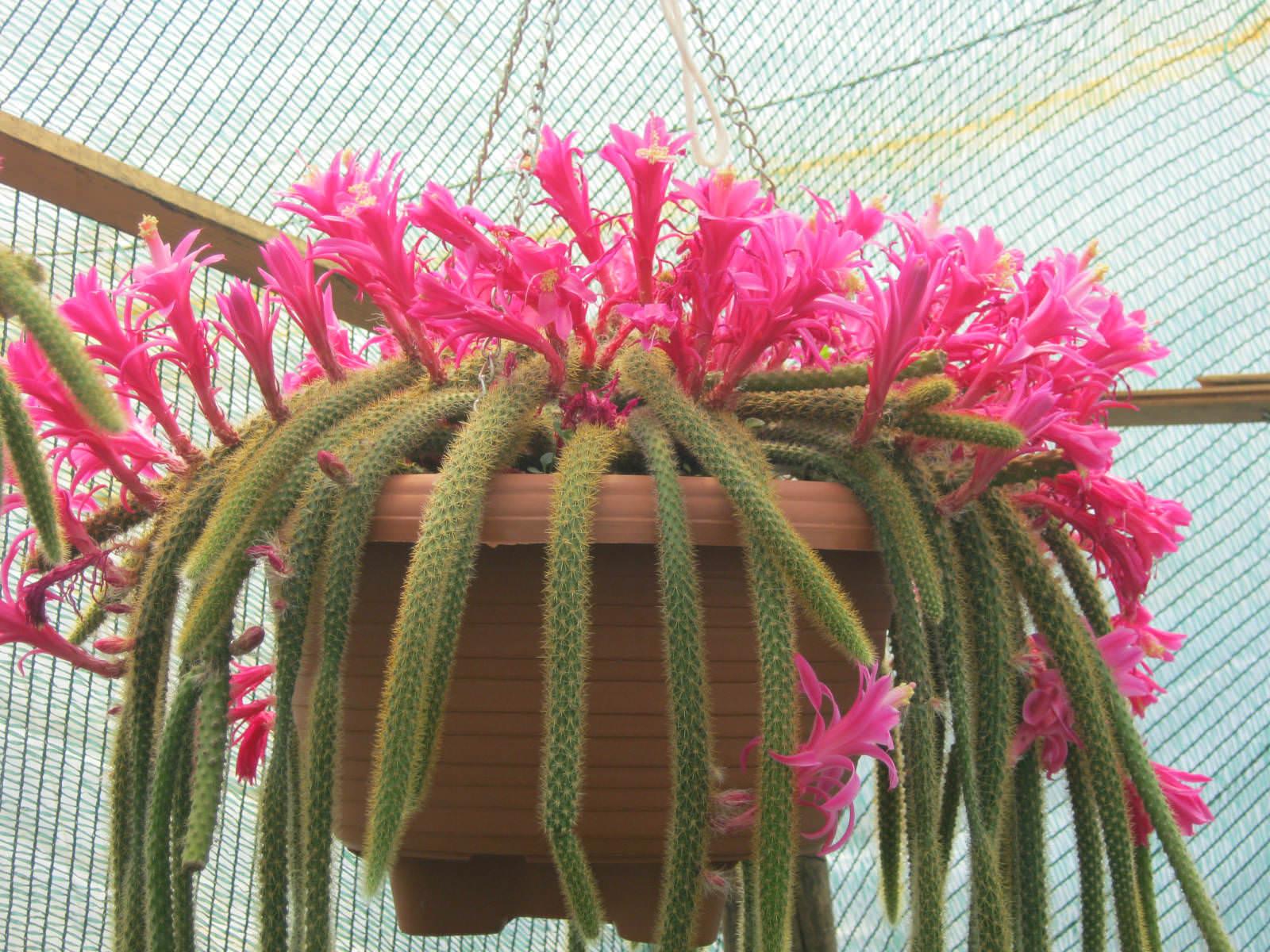
General Care
Disocactus flagelliformis is easy to cultivate and relatively fast growing cactus. Their trailing stems make these cacti ideal plants for a hanging basket. Line the basket with sphagnum moss before filling it with potting mixture and make sure it is hung where the prickly stems will not pose a treat to the unwary. If Disocactus flagelliformis is grown in a pot, hang the pot up or attache it to a high shelf. If it is left free-standing, it can soon be overbalanced by the lengthening stems.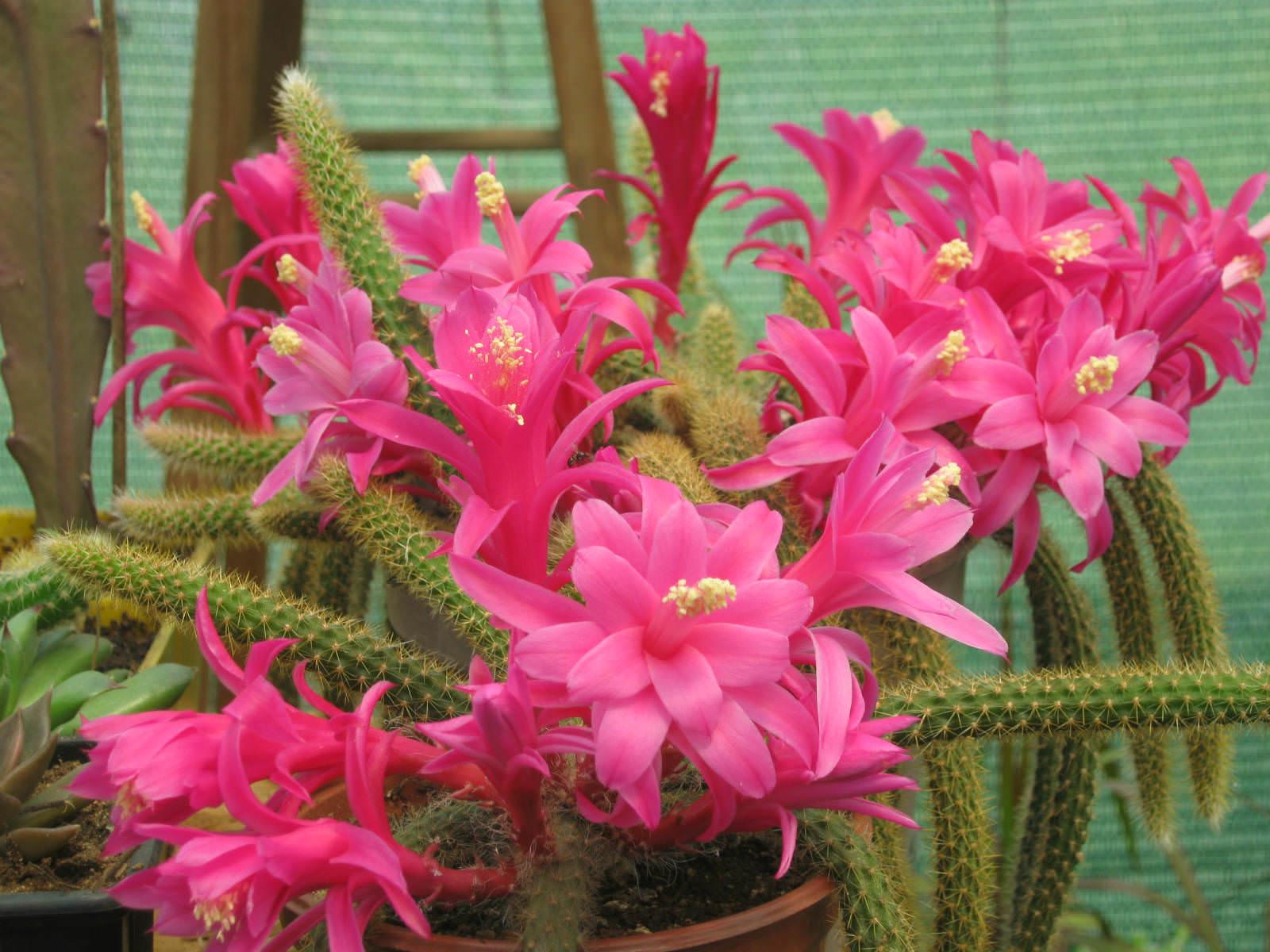
Propagation
To propagate, use either 6 inches (15 cm) tip or 6 inches (15 cm) segment of any part of the stem. Allow each cutting or segment to dry for three days; then insert it about 0.8 inch (2 cm) deep in a small pan or pot of the recommended potting mixture for mature plants; be sure that any stem segment is planted with the bottom end down. If this shallowly inserted cutting tends to fall over, it can be supported by being gently tied to a small wooden stick. Cultivation needs of cuttings are the same as those for mature Disocactus flagelliformis and rooting will occur within a few weeks.

Disocactus flagelliformis is epiphytic in the wild (it grows in trees). It is perfectly adapted to hanging baskets. It is the most cultivated species in the genus. Due to its ease of cultivation and attractive floral displays, Disocactus flagelliformis is often grown as an ornamental pot plant.

Growing Conditions
Light: Disocactus flagelliformis requires full sunlight. Hang the pot or basket in the sunniest window available. If possible, hang the plant outdoors in summer to give it fresh air and extra light.
Soil: A good draining soil mix that is gritty is advisable to use, which is sold and used for cacti and succulents.
Temperature: During the active growth period normal room temperatures are suitable. In winter these plants should be rested at 45 to 50 °F (7 to 10 °C), if possible, but they tolerate temperatures up to 59 to 61 °F (15 to 16 °C).
Watering: During the active growth period water plentifully, keeping the potting mixture thoroughly moist, but do not let plants stand in water. During the winter rest period just keep the mixture from drying out.
Fertilizing: Use half-strength liquid fertilizer sprayed on to the stems of the plant once every two weeks during the active growth period only.

General Care
Disocactus flagelliformis is easy to cultivate and relatively fast growing cactus. Their trailing stems make these cacti ideal plants for a hanging basket. Line the basket with sphagnum moss before filling it with potting mixture and make sure it is hung where the prickly stems will not pose a treat to the unwary. If Disocactus flagelliformis is grown in a pot, hang the pot up or attache it to a high shelf. If it is left free-standing, it can soon be overbalanced by the lengthening stems.

Propagation
To propagate, use either 6 inches (15 cm) tip or 6 inches (15 cm) segment of any part of the stem. Allow each cutting or segment to dry for three days; then insert it about 0.8 inch (2 cm) deep in a small pan or pot of the recommended potting mixture for mature plants; be sure that any stem segment is planted with the bottom end down. If this shallowly inserted cutting tends to fall over, it can be supported by being gently tied to a small wooden stick. Cultivation needs of cuttings are the same as those for mature Disocactus flagelliformis and rooting will occur within a few weeks.
0
0
文章
Dummer. ゛☀
2017年09月15日

Accidentally introduced from South America in the early 1900’s, red imported fire ants are currently found in 13 Southern states and Puerto Rico. They are well-known for their venomous sting and will aggressively attack anything that disturbs their mound. Fire ants can sting repeatedly and cause medical and agricultural problems to people, pets, livestock and wildlife. They will also wreak havoc on local ecosystems. Studies show that populations of ground nesting animals (song birds, snakes, rodents, toads and lizards) are reduced by more than half shortly after their arrival.
Imported fire ants (1/8 – 1/4 inch long) are reddish brown to black in color and look very much like ordinary ants. They are social insects and build mounds of loose soil, resembling gopher diggings, rarely larger than 18 inches in diameter. Mounds are often numerous and can quickly spread over an entire yard. Each mound may contain up to 300,000 ants.
Note: Fire ants are attracted to electricity and have been known to damage air conditioners, heat pumps, transformers and more.
Life Cycle
All ants are social insects and live in colonies with three distinct types of adults, called castes. Queens are larger than other ants and are responsible for egg laying. Some colonies have only one queen, whereas others have many. Males are responsible for mating with the queens; they do not participate in any other activities. Workers are sterile wingless females. They make up the bulk of the colony and are responsible for building and defending the nest, caring for the young and foraging for food.
During the spring and summer, winged males and females leave the mound and mate in the air. Fertilized females (queens) shed their wings, burrow into the ground and lay eggs to begin a new colony. After about 30 days, the eggs hatch into “maggot-like” larvae. These are cared for by the queen until they pupate approximately 1-2 months later. Within three weeks, the pupae transform into adult “worker” ants which begin collecting food for themselves, the queen and for future generations of larvae. In the late fall, numerous small colonies appear, many of which will not survive the winter unless the weather is mild.
Control
According to the University of Florida Extension, food-grade diatomaceous earth will eliminate individual ants, but its effectiveness to kill the entire colony is questionable.
Using a sprinkler can, mix 2 oz Monterey Garden Insect Spray (spinosad) per gallon of water, and apply to individual mounds as a drench. Use about 10% of prepared solution around the perimeter of the mound and the remainder directly over the mound. Apply slowly, like a gentle rain — do NOT disturb the colony. For best results, apply when the weather is cool or in early morning or evening.
Labeled for use in and around homes, Ascend contains a naturally occurring soil fungus — Abamectin — that will eliminate problem colonies and prevent queen egg production. Broadcast after dew or rainfall at a rate of 1 lb per acre (2lb container treats 36 mounds).
Least-toxic botanical insecticides, containing liquid pyrethrin, should be used as a last resort. Derived from plants which have insecticidal properties, these natural pesticides have fewer harmful side effects than synthetic chemicals and break down more quickly in the environment.

Imported fire ants (1/8 – 1/4 inch long) are reddish brown to black in color and look very much like ordinary ants. They are social insects and build mounds of loose soil, resembling gopher diggings, rarely larger than 18 inches in diameter. Mounds are often numerous and can quickly spread over an entire yard. Each mound may contain up to 300,000 ants.
Note: Fire ants are attracted to electricity and have been known to damage air conditioners, heat pumps, transformers and more.

Life Cycle
All ants are social insects and live in colonies with three distinct types of adults, called castes. Queens are larger than other ants and are responsible for egg laying. Some colonies have only one queen, whereas others have many. Males are responsible for mating with the queens; they do not participate in any other activities. Workers are sterile wingless females. They make up the bulk of the colony and are responsible for building and defending the nest, caring for the young and foraging for food.
During the spring and summer, winged males and females leave the mound and mate in the air. Fertilized females (queens) shed their wings, burrow into the ground and lay eggs to begin a new colony. After about 30 days, the eggs hatch into “maggot-like” larvae. These are cared for by the queen until they pupate approximately 1-2 months later. Within three weeks, the pupae transform into adult “worker” ants which begin collecting food for themselves, the queen and for future generations of larvae. In the late fall, numerous small colonies appear, many of which will not survive the winter unless the weather is mild.

Control
According to the University of Florida Extension, food-grade diatomaceous earth will eliminate individual ants, but its effectiveness to kill the entire colony is questionable.
Using a sprinkler can, mix 2 oz Monterey Garden Insect Spray (spinosad) per gallon of water, and apply to individual mounds as a drench. Use about 10% of prepared solution around the perimeter of the mound and the remainder directly over the mound. Apply slowly, like a gentle rain — do NOT disturb the colony. For best results, apply when the weather is cool or in early morning or evening.

Labeled for use in and around homes, Ascend contains a naturally occurring soil fungus — Abamectin — that will eliminate problem colonies and prevent queen egg production. Broadcast after dew or rainfall at a rate of 1 lb per acre (2lb container treats 36 mounds).
Least-toxic botanical insecticides, containing liquid pyrethrin, should be used as a last resort. Derived from plants which have insecticidal properties, these natural pesticides have fewer harmful side effects than synthetic chemicals and break down more quickly in the environment.
0
0
文章
Dummer. ゛☀
2017年09月14日

"How do I treat ants and sooty mold on a magnolia tree?" asked one reader recently. It is a common query. His question continued as follows:
"We have a four-year-old magnolia tree (4 inches in diameter and 13 feet in height) that has really never looked great but has always had nice white flowers in spring, at least. The leaves never got that real dark green look. Now, this summer, the leaves have started looking a lighter green and the bark has mold on it.
I have washed the mold off the bark and noticed at the base of the tree the bark is coming off about 4 inches up. I pulled the loose bark off, and under it there was a ton of ants. The layer of bark under that is still solid, but a few bore holes (the holes only go in a little bit, I think). We are in Florida."
Problems With Sooty Mold and Ants Actually Stem From Scale Insects
The ants and mold (it is probably the mold called "sooty mold") may be the effect, rather than the cause of your magnolia tree's problems. The real cause may be magnolia scale bugs. The scale insects secrete a liquid named "honeydew" that invites sooty mold. And because this honeydew -- true to its name -- is a very sweet substance, the ants like to feed on it. You can find information on organic ant control in a separate resource.
What Is Sooty Mold?
"Sooty mold" sounds disgusting, and it has an appearance to match.
It appears as a sickly, black film covering the bark and/or leaves of a plant. Known in scientific lingo as Capnodium, sooty mold is a kind of fungus.
As the University of Florida Extension points out, the sooty mold fungus, in and of itself, does not cause a direct problem for your plant, but rather an indirect one: namely, it inhibits the photosynthesis in a plant.
Photosynthesis is the very important process whereby the leaves of a plant convert nutrients into carbohydrates, by harnessing the energy derived from the rays of the sun. With a layer of sooty mold fungus covering the leaves of a plant, the sunlight cannot get through properly. The result is that the necessary photosynthesis can't take place, and the health of the plant suffers accordingly.
Scale insects are commonly the culprit behind this chain of events on magnolia trees. To fight these insects effectively, learn how to practice magnolia scale control. Other sucking insects also secrete honeydew, including:
Aphids
Mealybugs
Whiteflies
Take careful note that it is the sucking insects, rather than the sooty mold fungus or the ants, that you should be fighting. The fungus and the ants will go away once you have eliminated the sucking insects.
"We have a four-year-old magnolia tree (4 inches in diameter and 13 feet in height) that has really never looked great but has always had nice white flowers in spring, at least. The leaves never got that real dark green look. Now, this summer, the leaves have started looking a lighter green and the bark has mold on it.

I have washed the mold off the bark and noticed at the base of the tree the bark is coming off about 4 inches up. I pulled the loose bark off, and under it there was a ton of ants. The layer of bark under that is still solid, but a few bore holes (the holes only go in a little bit, I think). We are in Florida."
Problems With Sooty Mold and Ants Actually Stem From Scale Insects
The ants and mold (it is probably the mold called "sooty mold") may be the effect, rather than the cause of your magnolia tree's problems. The real cause may be magnolia scale bugs. The scale insects secrete a liquid named "honeydew" that invites sooty mold. And because this honeydew -- true to its name -- is a very sweet substance, the ants like to feed on it. You can find information on organic ant control in a separate resource.

What Is Sooty Mold?
"Sooty mold" sounds disgusting, and it has an appearance to match.
It appears as a sickly, black film covering the bark and/or leaves of a plant. Known in scientific lingo as Capnodium, sooty mold is a kind of fungus.
As the University of Florida Extension points out, the sooty mold fungus, in and of itself, does not cause a direct problem for your plant, but rather an indirect one: namely, it inhibits the photosynthesis in a plant.

Photosynthesis is the very important process whereby the leaves of a plant convert nutrients into carbohydrates, by harnessing the energy derived from the rays of the sun. With a layer of sooty mold fungus covering the leaves of a plant, the sunlight cannot get through properly. The result is that the necessary photosynthesis can't take place, and the health of the plant suffers accordingly.
Scale insects are commonly the culprit behind this chain of events on magnolia trees. To fight these insects effectively, learn how to practice magnolia scale control. Other sucking insects also secrete honeydew, including:
Aphids
Mealybugs
Whiteflies

Take careful note that it is the sucking insects, rather than the sooty mold fungus or the ants, that you should be fighting. The fungus and the ants will go away once you have eliminated the sucking insects.
0
0









